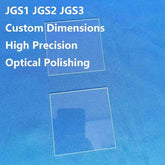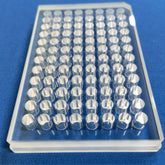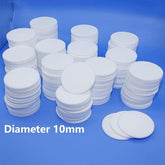The core advantages of sapphire windows in high-temperature environments
Sapphire plates, as a high-performance optical material, demonstrate unique advantages in applications in high-temperature environments. Its outstanding physical and chemical properties make it an ideal choice in extreme environments, especially in applications such as flame detection, industrial furnace observation, and aerospace. The following will analyze the core advantages of sapphire windows in high-temperature environments from multiple aspects.
1. Resistance to high temperatures
Sapphire (single crystal α-Al2O3) has a melting point of 2053°C, and its long-term working temperature can be reliably maintained at over 1900°C, far exceeding that of standard optical glass. This characteristic enables it to maintain structural integrity in high-temperature industrial scenarios, such as steel smelting and glass manufacturing. Sapphire windows, for instance, are used in the observation window of a steelmaking furnace. These windows are able to withstand the radiant heat of molten steel (above 1600°C) while also preventing cracking caused by thermal shock. Its coefficient of thermal expansion is only 6.7×10⁻⁶/K (within the range of 25-1000°C), which ensures its dimensional stability at high temperatures. This also ensures the focusing of the optical system.

2. Excellent heat conduction and thermal shock resistance
The thermal conductivity of sapphire is 25-35 W/(m·K), enabling it to quickly diffuse local high-temperature heat throughout the entire plate, thereby preventing deformation or failure caused by local overheating. In the context of flame detector applications, it is essential that the detector is directly exposed to open flames or high-temperature gas. Sapphire windows are able to conduct heat to the metal frame quickly, thereby maintaining the clarity of the optical channel through a heat dissipation design. Furthermore, it exhibits exceptional thermal shock resistance, capable of withstanding rapid temperature fluctuations from 1000°C to room temperature, rendering it well-suited for high-temperature equipment that necessitates frequent initiation and cessation.
3. High hardness and abrasion resistance
Sapphire, with its Mohs hardness of 9, has been shown to exhibit effective resistance to the erosion of dust and particles in high-temperature environments. In the observation window of coal-fired boilers or chemical reactors, the ash and catalyst particles carried by high-speed gas flow are difficult to cause damage to the sapphire surface. Therefore, the sapphire window remains smooth after long-term use.

4. A wide optical transmission range
Sapphire exhibits a high transmittance in the 0.15-5.5μm wavelength range, spanning from the ultraviolet to the mid-infrared spectrum. This property renders it particularly well-suited for the monitoring of high-temperature radiation spectra. For instance, when a spacecraft re-enters the atmosphere, sapphire portholes can transmit ultraviolet signals generated by high-temperature plasma, thereby enabling scientists to analyse the state of the thermal shield.
5. Chemical inertness and environmental tolerance
Sapphire displays excellent resistance to most acid, alkali and salt solutions. It is capable of withstanding high temperatures and pressures, making it suitable for use in corrosive environments, including petroleum cracking units. In contrast to calcium fluoride, it is resistant to hydrolysis and oxidation under these conditions. Furthermore, it boasts exceptional radiation resistance, with the capacity to endure 10⁶ Gy of gamma-ray irradiation. This renders it well-suited for specific applications, such as nuclear reactor monitoring.
6. Mechanical strength and sealing performance
The bending strength of sapphire can reach 400-700 MPa. Through special metallization edge treatment (such as molybdenum-manganese coating), the sapphire window can achieve a high-strength gas seal with the metal housing, and can withstand a vacuum environment of 10⁻⁸ Pa. This characteristic makes it suitable as the material for the observation window of the combustion chamber in aircraft engines. It can withstand 1500℃ high temperature while also resisting the mechanical stress caused by engine vibration.
Sapphire windows, owing to their superior performance characteristics, are increasingly being adopted in high-temperature industrial applications, energy systems, aerospace, and related fields. With the advancement of fabrication technologies and breakthroughs in the growth of large-scale single crystals, sapphire windows integrated with intelligent sensing capabilities, such as embedded temperature and pressure sensors, are poised to usher in a new era of intelligent monitoring for high-temperature equipment, thereby offering more reliable solutions to enhance industrial safety and operational efficiency.






